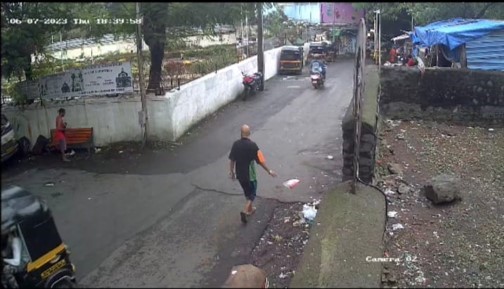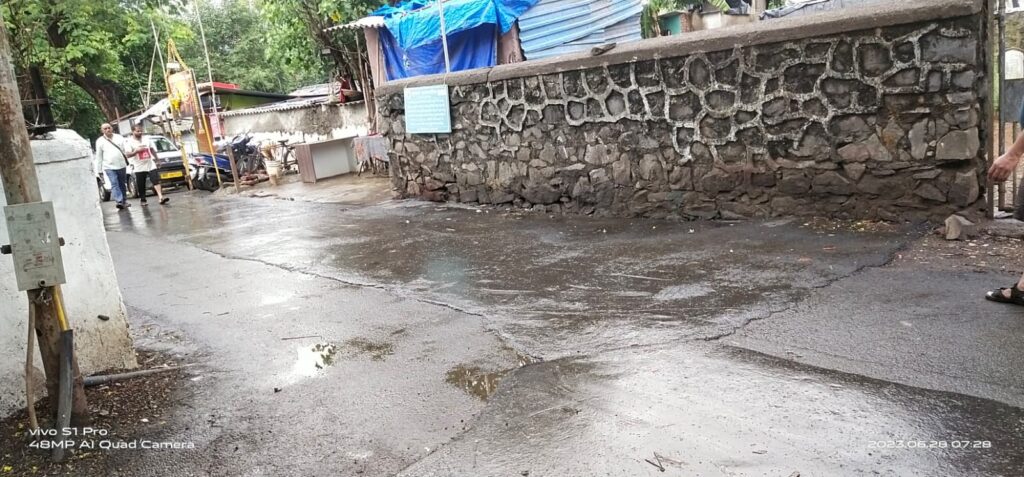Longtime locals of Bandra west tell stories of a peaceful, sleepy suburb it once was.
However, over the last couple of decades, they have seen a real estate boom transform the skyline into towering buildings, where once beautiful cottages stood. The same narrow roads accommodate thrice as many apartment blocks, causing a spike in population density, without any upgrade to the infrastructure.
At the end of what used to be called Cemetery Lane, now Khadeshwari Marg, are two cemeteries facing each other. The lane is just off Hill Road, famous for shopping and eateries.
Decades ago, this lane ended at the Arabian sea but overtime a large, congested informal settlement came up on the side of the hill bordering the sea. The narrow lanes between the houses are just enough for people to walk through to access their houses.
As door-to-door waste collection is not possible in this congested settlement, people dumped their daily household waste outside the lane. This place, like many other spots in crowded areas, is a Garbage Vulnerable Point (GVP). GVP is a common, accessible public space used to dump the waste, from where the Brihanmumbai Municipal Corporation (BMC) collects the garbage.
Few months ago, the garbage dump got pushed right in front of the main gate of the Bandra Jewish Cemetery.

An official board put up by the BMC stating that no garbage should be dumped at the cemetery gate, had the exact opposite impact. The board actually became the spot, where the garbage was thrown every day, helping people on scooters swiftly fling a bag of garbage, perfectly aimed at board, while riding by.
Moreover, BMC’s waste collection vans drove up to the spot and cleared the garbage every day. That further emboldened people to throw the waste.
Read more: We are like that only: Non-compliance of waste segregation makes Malad stink
Garbage piles up
In spite of this being a functional cemetery, it made no difference to anyone except for when a burial was to take place. The Jewish community used the other smaller side gate and bore the inconvenience of garbage at the main gate.
“It was a sorry sight. A garbage dump outside the main gate with the menace of rodents created an unhygienic situation. Since it is a narrow road, there was no place to walk without stepping on to the overflowing pile of kachhra,” says Joe Rego, who lives next door.

Things would be very different, if it was a housing complex, since residents would have objected and physically moved the dump. But it was at the cemetery wall, and no one objected.
Over time waste was also indiscriminately thrown over the cemetery wall into the compound creating a scaled down version of a landfill.
Stakeholders drive the transformation
In January 2023, the recently appointed chairman of the caretaker committee at the Bandra Jewish Cemetery decided to take matters into their hands and reach out for help.
In subsequent months, individual volunteer groups conducted three separate clean up drives within the cemetery compound, manually pulling out almost four truckloads of legacy waste from the compound.
The clean ups unearthed two graves of children near the wall previously lying unnoticed under the mounds of filth.
Meanwhile, a handful of local active citizens came together with neighbours to see what could be done to remedy the situation. The caretaker committee planned to restore dignity and grace to the holy ground through a new landscape design.
BMC gets into action
The problem of rodents needed urgent attention, before a garden could be planned. The rats were there for the garbage; they would not spare young plants. A few members approached the BMC to help, who were able to tackle the menace with successive rounds of pest control.
Simultaneously, the group held meetings with the officers from the Solid Waste Management (SWM) department of the H-West ward, which were followed up with installation of CCTV cameras on either side of the cemetery wall.
Joe offered to physically monitor the site on a daily basis, providing the background knowledge of the area. Thanks to the CCTV, persons who threw garbage at any time of the day or night, were clearly captured on camera. The real time footage, accessible through remote access, was downloaded and shared on a common WhatsApp group comprising of the committee members, activists and BMC officers.
The BMC appointed personnel called a Nuisance Detector (ND) (or Swachhtadoot). They spoke to the identified community members and convinced them to avoid throwing the garbage and to instead give the waste to the BMC collectors.

Lillian Pais, who coordinated closely with the BMC officers, strongly advocates the use of technology in resolving difficult yet sensitive issues.
“BMC officers worked with us to understand the situation and chalk out the plan of action. They provided us with an ND who was physically present at the site and monitored the situation on a daily basis. That made a huge difference as people became aware of the seriousness of the issue and started cooperating,” says Lilian. “Another challenge was identifying the offending citizens. This was effectively solved by the CCTV cameras. Screen grabs of the litterers helped identify and stem the flow of garbage being dumped.”
Gradually, the amount of garbage being dumped started reducing. And as of end of July, there have been several zero garbage days.
Read more: Mumbai’s no.1 source of trash: Food waste
Building on the success
The problem of littering persists. The group wishes to engage an organisation working in SWM that can design a program specifically targeted at people who continue to throw garbage. Understanding the reasons could also help find alternatives to everyone’s satisfaction.
While the caretaker committee of the Bandra Jewish Committee is pleased with the outcome of this community led voluntary project, there is still a lot to be done.
“We have been fortunate to have the support of a group of volunteers and citizen activists, who knew the authorities and knew exactly what needed to be done. For example, putting up the CCTV was not a step I was aware of but it made all the difference,” says Abraham Yehuda, chairman of the caretaker committee of the Bandra Jewish Cemetery.
“We have plans to restore the cemetery to a beautiful, functional space, where members can grieve the loss of their loved ones in peace. There is a lot more to be done but eliminating the garbage dump has set the ball rolling towards transforming the place.”
The members say that once the community gets involved in resolving their civic issues, it can make a real difference in resolving seemingly insurmountable problems.
Imagine what can be achieved if we had a lot more active citizens with time and interest to spare towards improving their lives and those of the communities they live in.
How to replicate this model in other areas:
- Firstly get your team together comprising of local residents, relevant department members from the municipal corporation and local, civic activists. The most convenient way to communicate is to form a WhatsApp group with strict administration allowing no messages other than those related to the mission of the group.
- Mutually arrive at the goal, whether it is to eliminate a garbage dump or anything else and make that the “mission” of the group; thus guiding and directing all efforts of the group towards that one main goal.
- Assign work to each team member, for example one key point of contact to coordinate with the municipality, one to coordinate daily visits to the site etc. Each one is in charge of a defined, specific task so that all contribute towards different tasks of the same goal.
- Fix a timeline for the project as a whole and deadlines for individual tasks. This ensures timely follow up and the end/accomplishment is in sight.
- If one avenue of pursuit is not working out, quickly discard it and replace with a more workable and doable alternative and move on. The point is to keep moving and get things done, not on how you do it.
- Lastly, consistency and courtesy while engaging with all stakeholders is crucial to achieving the end goal. Everyone is giving their time and effort voluntarily. So, why not have a mutually enjoyable interaction demonstrating real camaraderie in the true spirit of citizenship?
If you wish to fix a civic issue in your neighbourhood but don’t know how to get started, send a WhatsApp message Lillian Pais on 9920663748, a key member of the group.